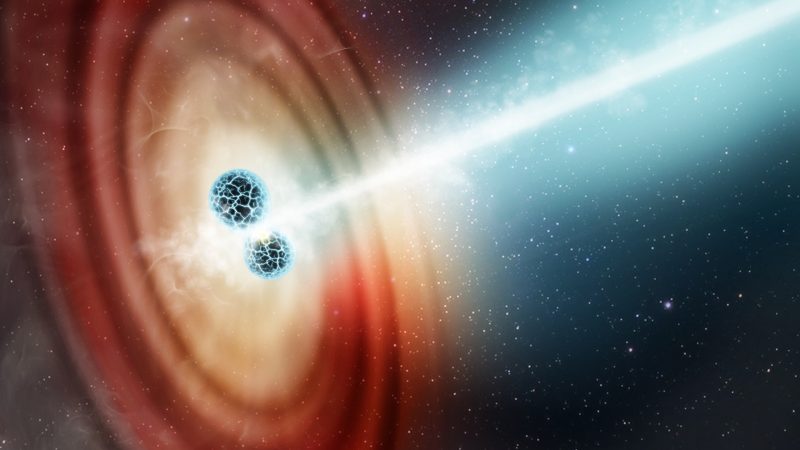A mighty collision and a super-fast jet
According to the known laws of physics, nothing can travel faster than light. And it’s rare to see any space objects traveling at speeds anywhere even close to the speed of light, although some relativistic jets from exotic phenomena like black holes, pulsars and quasars do sometimes move nearly that fast. But now astronomers have found a super-fast jet, plowing through space at speeds greater than 99.97% the speed of light. Wow!
NASA said on October 12, 2022 that astronomers used the Hubble Space Telescope to measure the speed of this jet, which they believe sprang into being when two neutron stars collided. They’ve named this event GW170817 and said the energy from the collision was comparable to that of a supernova, or exploding star, which can emit more energy in a few seconds than our sun will radiate in its lifetime of billions of years. NASA said the discovery and analysis of the jet was:
… A major watershed in the ongoing investigation of these extraordinary collisions. The aftermath of this merger was collectively seen by 70 observatories around the globe and in space, across a broad swath of the electromagnetic spectrum in addition to the gravitational wave detection.
The study was published October 13, 2022 in the peer-reviewed journal Nature.
Here’s what happened
Astronomers first noticed the neutron star explosion in August, 2017. And, they said:
Scientists quickly aimed Hubble at the site of the explosion just two days later. The neutron stars collapsed into a black hole whose powerful gravity began pulling material toward it. That material formed a rapidly-spinning disk that generated jets moving outward from its poles. The roaring jet smashed into and swept up material in the expanding shell of explosion debris. This included a blob of material through which a jet emerged.
While the event took place in 2017, it has taken several years for scientists to come up with a way to analyze the Hubble data and data from other telescopes to paint this full picture.
The Hubble observation was combined with observations from multiple National Science Foundation radio telescopes working together for very long baseline interferometry (VLBI). The radio data were taken 75 days and 230 days after the explosion.
Kunal P. Mooley of Caltech in Pasadena, California, lead author of the Nature paper, commented:
I’m amazed that Hubble could give us such a precise measurement, which rivals the precision achieved by powerful radio VLBI telescopes spread across the globe.
The authors used Hubble data together with data from ESA’s (the European Space Agency) Gaia satellite, in addition to VLBI, to achieve extreme precision. Jay Anderson of the Space Telescope Science Institute in Baltimore, Maryland, explained:
It took months of careful analysis of the data to make this measurement.
Super-fast jet faster than light?
By combining the different observations, they were able to pinpoint the explosion site. The Hubble measurement showed the jet was moving at an apparent velocity of seven times the speed of light. The radio observations show the jet later had decelerated to an apparent speed of four times faster than the speed of light.
But, as noted at the top of this page, nothing can travel faster than light, according to the known laws of physics. So today’s astronomers agree that this superluminal motion is an illusion. The astronomers explained:
Because the jet is approaching Earth at nearly the speed of light, the light it emits at a later time has a shorter distance to go. In essence the jet is chasing its own light. In actuality, more time has passed between the jet’s emission of the light than the observer thinks. This causes the object’s velocity to be overestimated – in this case seemingly exceeding the speed of light.
Wenbin Lu of the University of California, Berkeley confirmed:
Our result indicates that the jet was moving at least at 99.97% the speed of light when it was launched.
Why astronomers are excited
These astronomers called the work “a significant breakthrough” for two emerging and interrelated fields of study. One is time domain astronomy (studying how space objects change over time). And the other is multi-messenger astronomy (using various sorts of signals, like light and gravitational waves, to study a single astrophysical object or event).
They said the Hubble measurements, combined with the VLBI measurements (announced in 2018:
… Greatly strengthen the long-presumed connection between neutron star mergers and short-duration gamma-ray bursts. That connection requires a fast-moving jet to emerge, which has now been measured in GW170817.
They also said this work paves the way for more precision studies of neutron star mergers, adding:
With a large enough sample over the coming years, relativistic jet observations might provide another line of inquiry into measuring the universe’s expansion rate, associated with a number known as the Hubble constant.

Bottom line: Astronomers discovered and now have measured a super-fast jet, thought to be the result of 2 neutron stars colliding. Material in the jet is moving at 99.97% the speed of light!
Source: Optical superluminal motion measurement in the neutron-star merger GW170817
Super-fast jet blasts from neutron star collision - EarthSky
Read More
No comments:
Post a Comment